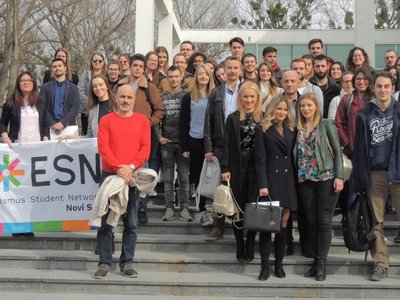

She contemplates on the journey from the first mobilities in 2004, continues with the Erasmus Mundus cooperation with the University of Graz, transits over to the surge of mobilities with the beginning of the Erasmus+ action KA107, and finally reflects on the benefits of the full integration into the Erasmus+ programme in 2019.
Can we really measure the value of Erasmus+ mobility?
Dealing with international relations at the University of Novi Sad, Serbia, for almost two decades, but also having a personal Erasmus Mundus student experience and multiple Erasmus+ staff mobility opportunities in my professional field of internationalisation, I have found myself thinking about the Erasmus+ mobility programme with huge appreciation and from many different, but interrelated, perspectives.
The personal one is something I tend to see in the majority of Erasmus+ mobile participants who shared their views with me. You strengthen your competences and self-confidence, you expand your professional network to create more activities in the future and you truly feel enriched by the experience which managed to create such strong bonds with other countries, traditions, and most importantly, people.
One of the advantages of leading an international relations office for a long time is that you become one of the bearers of institutional memory and its evolution in a particular field. I clearly remember the excitement and challenges of sending five students on mobility in 2004 and receiving two foreign students in 2005, who were even picked up from the airport by our rector’s car. It was such an achievement for us in the period when Serbian universities were not part of any EU mobility programmes and the university had no institutional structures or processes that provided a framework for dealing with student and staff mobility.
As time passed, the University of Novi Sad gained more experience and opportunities through Erasmus Mundus External Cooperation Window (EM ECW) projects. Especially the JoinEU-SEE project with the University of Graz as the coordinator was one of the milestones in our internationalization roadmap. Through the participation in EM ECW projects, we achieved higher numbers of grant holders in both directions and we were able to kickstart institutional changes. The big breakthrough, however, came through the participation in the Erasmus+ KA107 programme. It immediately became the largest and most comprehensive mobility programme at our university, with more than 2500 outgoing and 1300 incoming students and staff, from 2015/2016 until 2019/2020, based on hundreds of Erasmus+ inter-institutional agreements, with universities across 27 programme countries. Particularly successful was the cooperation with the Austrian HEIs, which built upon the trust already achieved through various projects that came beforehand.
So, what did Erasmus+ KA107 programme do to, and within, the University of Novi Sad for it to be able to achieve these results and become a leader in academic mobility in the Western Balkans? I would argue that behind these figures, there have been some crucial underlying processes. First and foremost, the strengthening of the integrative function of internationalisation on the University as a whole, since our faculties are separate legal entities and there are many differences in how they respond and carry out activities. Then, the substantial capacity building and quality raising mechanism of Erasmus+ for the University and faculty services, that became visible to us as we introduced and updated regulations, fine-tuned the coordination structures, increased the number of Erasmus+ coordinators across the faculties and departments, used academic mobility in a more strategic way, and all the other aspects of quality in internationalisation that made it possible for us to apply successfully for ECHE.
Can we really measure the value of Erasmus+ mobility? I don’t believe it is possible.
However, I do think it is of crucial importance to be aware of the incredible scope and depth of it, of all those invisible added values that go beyond the figures and statistics we all like to present.
It is this awareness that will keep us motivated, particularly as Serbia now enters the global outreach of the Erasmus+ programme.
